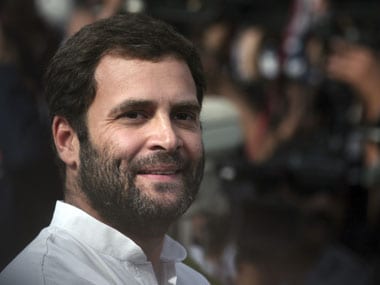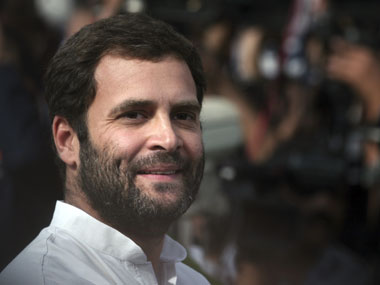The first time when Congress vice president Rahul Gandhi mocked the Narendra Modi government as a “suit boot ki sarkar” and went on with his snide remarks against it on the floor of the Parliament, it appeared to have caught the fancy of the nation like never before. For a moment, he looked spontaneous and capable of “attack communication” that’s integral to competitive politics in any country. His aggression was right, sarcasm well-placed and modulation, uncharacteristic of a lazy novice that he is often compared to. But on Tuesday, when he addressed a Youth Congress rally at Kozhikode in Kerala and repeated the “suit boot” allegory against Modi’s government and described how it betrayed the interests of farmers to help big corporates, it hardly evoked any response. The translator’s efforts to spice it up by adding more aggression made it look ludicrous. But that didn’t stop Rahul from hitting the suit-boot theme again on Wednesday saying the Congress wouldn’t be intimidated by the Prime Minister and “five or six of his friends in suits”. [caption id=“attachment_2265324” align=“alignleft” width=“380”]  Rahul Gandhi in a file photo. Reuters[/caption] The occasion, which should have been a morale booster for the party that would be seeking a re-election in the state in less than a year, turned out to be a repeat of a standardised show with no context, strategy and purpose because Rahul was barking up the wrong tree. For the Congress and the ruling United Democratic Front (UDF) that it leads in the state, Modi or the BJP are not the political adversaries, but the CPM. In fact, electorally Modi and the BJP don’t even matter, but still Rahul chose to target them and not the CPM that seems to be winning in its adversarial communication battle against the Congress. A slew of scams and allegations of bribery have sunk the Congress and the UDF along with whatever good things it has done over the last four years. What the party required, even to stay afloat, was an all-out strategic attack against the CPM and the Left while trumpeting its own success stories. But laughably, Rahul chose to speak about Modi and his suit and boot while his followers faked adulation. What the rally in Kozhikode witnessed was the acute weakness in Rahul’s template-based political campaign and how it wastes opportunities. It also portends a disastrous national campaign for the Congress in its existing pockets of influence in the next elections. The “suit-boot” speech, that is replete with references to Modi’s sartorial profligacy and his sympathy with corporates, has been standardised and made into a template that he seems to have by-hearted. Now, whether it makes sense or not, he delivers it ad nauseum. As social scientist Shiv Vishwanathan noted in 2013, he still “seems like someone carrying out duties” and “his speech is repetitive.” In comparison, Modi is so spontaneous and strategic in picking on his adversaries. Although Sonia and Rahul had been his bugbears in political speeches, when he went to Tamil Nadu prior to the elections in April 2014, it was not the Congress that he targeted, but the Dravidian parties, although his object of attack in an earlier rally in February was the UPA government. The February rally was obviously meant for a wider audience across the country because every single speech of his was being televised, while the second in April, close to the elections, was meant to change the minds of Tamil voters. Modi’s bracketing the AIADMK and the DMK together did surprise political observers because he had been discernibly soft on Jayalalithaa and her party, but at a critical situation, he didn’t mind targeting his friend. Inevitably, Jaya too hit him back although her party also had been tactically soft on Modi and the BJP. He spared the Congress, because it hardly mattered in Tamil Nadu. That’s the essence of political communication. Similarly, Modi doesn’t fail to shift his goalposts when he goes to Bihar or West Bengal. He has the same vituperation, but different political targets, different stories and jokes, and altogether different narratives. Rahul’s show in Kerala should worry the Congress, both in the state and at the Centre, because strategic communication is critical to political theatre. Professional politicians know that by instinct and practice, but Rahul lacks it because he still doesn’t recognise his own weakness and the weakness of his party’s leadership. What the Chief Minister Oomen Chandy, who is literally sinking in a cesspool of corruption charges, would have wanted from Rahul would have been the allure of the Nehru-Indira dynasty that always worked in the state and a frontal attack on the CPM. But what he got instead was an uninspiring repeat of his broadside against a non-existent enemy. Besides Rahul’s limitation of skills, it’s also the problem with the high command culture of the Congress and its highly centralised management of the party. When Rahul goes into the field, he should take notes from local leaders and not his coterie in Delhi. He and his think-tank should realise that templates don’t work in cut-throat politics, and if he is incapable of thinking on his feet, he should master a wide variety of templates as method actors do.
For the Congress and the ruling United Democratic Front (UDF) that it leads in the state, Modi or the BJP are not the political adversaries, but the CPM. Hence Rahul barked up the wrong tree with his anti-Modi tirade in Kerala.
Advertisement
End of Article


)
)
)
)
)
)
)
)
)



